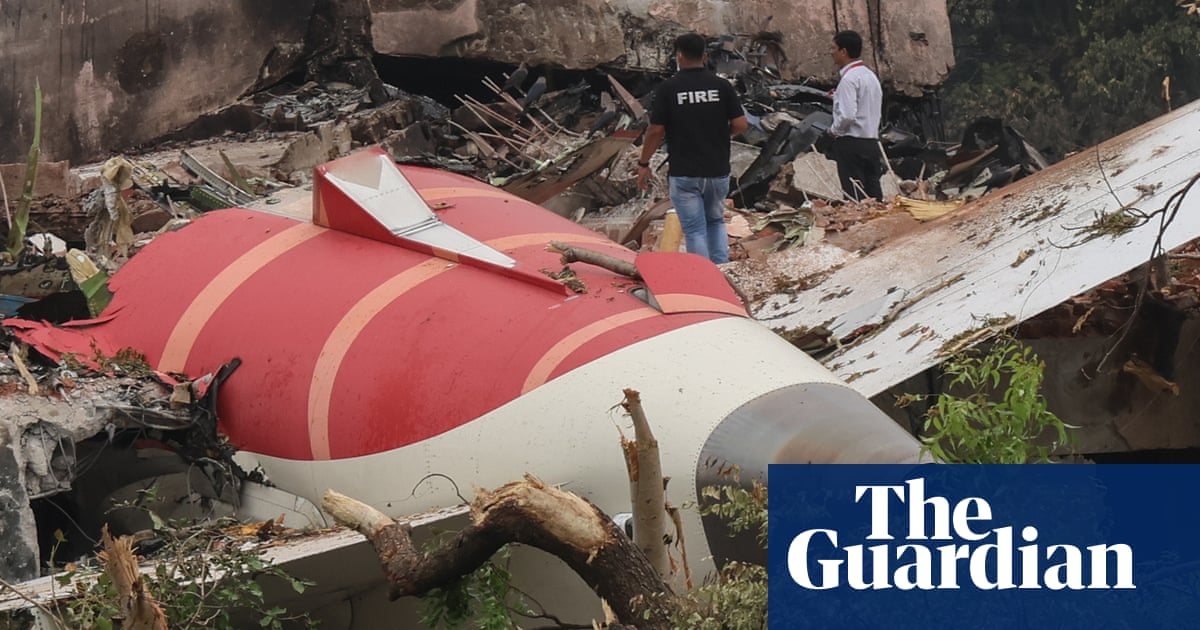Recovery teams have found one of two black boxes from the wreckage of Thursday’s AirIndiacrash in Ahmedabad, police sources have said.
Teams continued on Friday to search the wreckageof the Boeing 787 Dreamliner aircraft and the buildings into which it crashed, including a staff hostel at a nearby hospital, in the hope of identifying the 241 passengers and unconfirmed numbers of people on the ground who died.
Grieving families queued at a hospital in the northern Indian city to give DNA samples of their loved ones.
All but one of the 242 passengers on board the London-bound flight were killed when it ploughed into a residential district shortly after takeoff and exploded. Kanan Desai, the deputy commissioner of police in the city, said 265 bodies had so far been counted, suggesting at least 24 people died on the ground.
In emotional scenes, family members gathered at an emergency centre in the hope of retrieving their loved ones’ remains.
Ashfaque Nanabawa, 40, said he was searching for his cousin Akeel Nanabawa, and his cousin’s wife and three-year-old daughter, who had been onboard. They had spoken with his cousin on the plane just before takeoff, he said. “He called us and he said: ‘I am in the plane and I have boarded safely and everything was OK.’ That was his last call.”
Another woman, who did not give her name, said her son-in-law had been killed. “My daughter doesn’t know that he’s no more,” she said, wiping away tears. “I can’t break the news to her, can someone else do that please?”
Others hunted for people who had been in the damaged buildings. Thakur Ravi, who worked in the kitchen at the BJ Medical College hostel, was searching for his mother, a cook, and his two-year-old daughter, who he had left in her care.
The last time he saw them was before he set off to deliver lunch boxes to senior doctors at the hospital, about half an hour before the crash, he said. “All the other ladies who cook food at the hostel managed to escape, but my mother and daughter got left inside. I have searched everywhere but have not found them,” he said.
The plane, which was bound for London Gatwick, was carrying 169 Indians,53 Britons, seven Portuguese nationals and one Canadian, whose identities have been emerging as their families have confirmed their loss.
Among the Britons was Dr Prateek Joshi, a hospital radiologist based in Derby, his wife, Komi Vyas, also a medic, and their three children. They had shared a beaming selfie moments before takeoff as they sat on the plane. The media outletNDTV saidVyas had recently left her job at a hospital in Udaipur to take the family to join her husband in the UK.
Akeel Nanabawa, a businessman based in Gloucester,also died, along with his wife, Hannaa Vorajee, and their four-year-old daughter, Sara. In a statement, their family said they were “widely loved and deeply respected. His quiet generosity, her warmth and kindness and their daughter’s bright, joyful spirit made a lasting impact on everyone who knew them. She was a ray of sunshine in her school and they were a pillar of strength in our lives.”
A British man, Vishwash Kumar Ramesh, who miraculously walked from the wreckage with minor injuries, has described the horror of watching people “dying in front of my eyes”. Speaking on Friday from a hospital bed where he is recovering from burns, Ramesh, 40, told the local broadcaster DD News that before the moment of impact the plane had seemed to be “stuck” in the air.
Sign up toHeadlines UK
Get the day’s headlines and highlights emailed direct to you every morning
after newsletter promotion
“When the flight took off, within five to 10 seconds it felt like it was stuck in the air. Suddenly, the lights started flickering – green and white. The aircraft wasn’t gaining altitude and was just gliding before it suddenly slammed into a building and exploded.”
Ramesh, who was sitting in seat 11A, next to one of the emergency exits, had thought he was dead, he said. “Later, I realised I was still alive and saw an opening in the fuselage. I managed to unbuckle myself, used my leg to push through that opening, and crawled out.” He added: “I don’t know how I survived.I saw people dying in front of my eyes– the air hostesses, and two people I saw near me.”
He was visited in hospital on Friday by India’s prime minister, Narendra Modi, who also toured the site of the crash and was briefed by officials. “The scene of devastation is saddening,” Modi said in a post on X. “Our thoughts remain with those who lost their loved ones in this unimaginable tragedy.”
India’s Aircraft Accident Investigation Bureau is leading the inquiry into the cause of the crash, helped by teams from the US and UK.
Boeing’s chief executive, Kelly Ortberg, said the company was supporting the investigation. “Safety is foundational to our industry and is at the core of everything that we do. Our technical experts are prepared to assist investigators to understand the circumstances and a Boeing team stands ready to travel to India,” he said.
Tata Group, Air India’s owner, offered 10 million rupees ($117,000) to “the families of each person who has lost their life in this tragedy”, as well as promising to cover the medical expenses of those injured.
